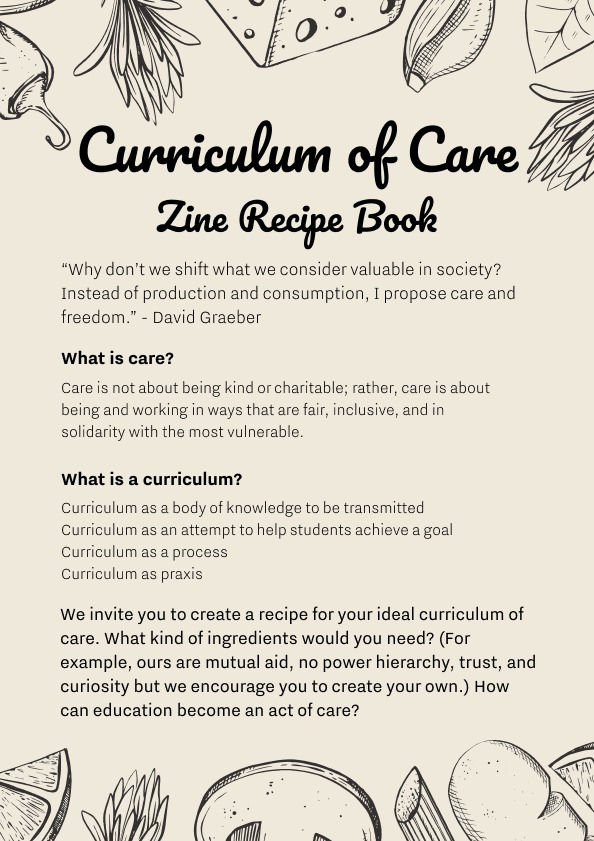Week 3: Visual Assembly
- vickisun4
- Jul 11, 2022
- 4 min read
Updated: Jul 31, 2023
May 16 to May 20, 2022
Partners: Anya, Bipasha, Dany, Farah, Faiza, May, Sofia, Ziyuan, This Ain't Rock n Roll
Brief: Design and facilitate a Visual Assembly on the topic of The Curriculum of Care
With a strong conceptual foundation and some initial research under our belts, we started to plan our next workshops. We decided on the following:
1. Workshops to materialize/visualize the submissions to our prompt
2. Open Discussion/Interviews
3. Zine Workshop
Animal Workshop
We wanted to expand the horizons for what could be considered care outside of conventional parameters. So, we eventually came up with the idea of a workshop for non-humans/animals. We would provide different materials for the workshop participants to construct a school for animals with their own values and curricula.

We also decided that halfway through the construction of their schools, each group with switch models with one another and then build upon the previous model.
Materials
We provided the groups with colored pens and pencils, toothpicks, cotton balls, string, cardboard, and other craft materials.
Making
Final Outcome
first group explaining their school
second group explaining their school
Takeaways
From this workshop, we were able to practice our facilitation skills and work out the details of momentum and proper pacing.
We also took note of the values that came through from each group. The participants were able to put themselves in the position of non-humans and design from their perspective. They wanted inclusive spaces and applied some already-known concepts to humans, like inclusivity, accessibility, etc. We also liked the cooperation aspect of the workshop.
Open Discussion
While Dany, Farah, and Ziyuan were leading the animal workshop, Sofia and I embarked on our interviews with students and staff around LCC. We wanted to do this in an open discussion format, where the students and staff could freely talk while we asked some guiding questions.

We interviewed a total of eight people: five of whom were Bachelors students and three of whom were technicians at LCC.
From our interviews, we noticed some themes:
- students felt more cared for by the technicians than their tutors
- students did not like online classes
- students wanted more support for their mental health
- both students and technicians wanted the school to do more to address racism and sexism
Their answers provided real-world examples of care in the context of LCC and UAL. They valued empathy and being physically present in classes.
We also asked them about the materiality of care i.e. what material they associate with care. Several of them answered fabric, and one said that he imagined a table where he could sit and talk to his manager. The table provides a sense of grounding and equal footing.
Transcripts of Interviews. Analysis by Sofia

Color Key for Analysis of Interviews
Takeaway
We gained some central values from the interview, such as physicality, peer-to-peer knowledge exchange, and physical manifestations of care such as fabric and a table.
We thought about Christo's wrapping of the Reichstag for a possible visual outcome. We also considered quilts and blankets.

Branding
There were several wheels moving at the same time, and in addition to our workshops, we needed to start thinking about our branding. We decided that we want bold typography, minimal, uncrowded visual elements, and striking colors.
We looked at the punk movement, Constructivism, May '68 posters, and posters from other protest movements from different points in history.



Tote Bags and Buttons
We voted together as a group on different color schemes, visual elements, and the content of the posters. We wanted to deconstruct the traditional idea of education, so we thought about incorporating an institution into our poster with something on top, either crossing it out or reinventing it in some way.

We also thought more about whether we wanted a performance in our visual assembly or some sort of art project. We considered the role of court jesters, who used to tease and provoke court members using humor.
Feedback
A few highlights/provocations from the feedback: John asked us why an Arts and Design school should care about care? What is a curriculum? What is the most radical space we can make?
He also said that if we want a certain outcome from our workshops, we should add more parameters.
Re: branding, we should consider why certain branding strategies work better than others.
John said it was smart of us to start with values and then move to workshops for modelling care and then on toward our visuals.
values --> model --> visuals
He also suggested that we take a syntagmatic approach where we begin to map our values to curriculum entities. For example, with mutual aid, how do we apply this value to assessment criteria or entry requirements?
What do we want to communicate?
With Al, Clive, and Tonicha, they said that care is concealed by the transactions that we make. Al suggested that we look at repair as an act of care. Through caring for things or repair, it would be a way to resist disposability and consumer culture.
For a possible final outcome, we could go to the canteen and just start cleaning. How do we understand a space from cleaning it? In a way, it would be a ritualization of cleaning.
The key words from this were cleaning, maintenance, and care.
Key Takeaways
We gained more practice from facilitating workshops and open discussions
We had more visualizations of care from the workshops and interviews
We began narrowing in on the prompts/questions that we would want to incorporate in the final Visual Assembly.

































Comments